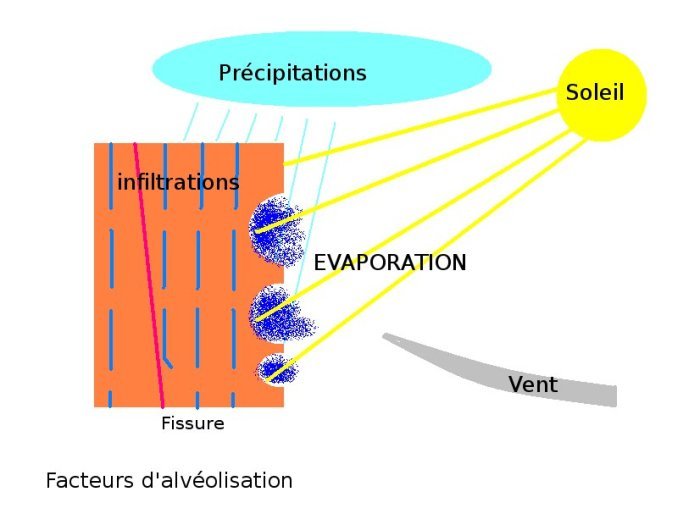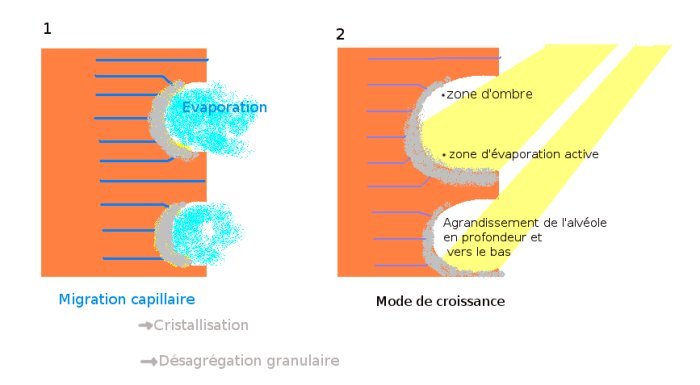Le grès vosgien du château de Salm
Earthcache

Le château de Salm
Ref.Doc.: https://fr.wikipedia.org/wiki/Ch%C3%A2teau_de_Salm#Histoire
Le château de Salm est élevé entre 1205 et 1225 par Henri III, comte de Salm (de Haute Lorraine), sur le territoire de l'abbaye de Senones dont il est l'avoué.
La guerre qu’entreprend le duc Charles le Téméraire contre le duc de Lorraine et ses vassaux semble avoir été fatale au château, lequel est vraisemblablement ruiné en 1475.
Du château comtal de Salm subsistent des ruines surplombant la vallée de la Bruche, sur la commune de La Broque dans le Bas-Rhin.
Intégrés au territoire allemand par le traité de Francfort en 1870, les vestiges sont classés Monument Historique par l'Administration Impériale d'Alsace-Lorraine le 6 décembre 1898.
Le grès est une roche détritique et sédimentaire, issue de l’agrégation et la cimentation ou diagenèse, de grains de sable. Il s'agit d'une roche cohérente et dure.
Les grains, et le ciment entre ces grains peuvent avoir une composition différente selon l’origine et l’histoire de ce grès. Les dépôts successifs de sable se retrouvent dans la stratification du grès. La roche prend des couleurs différentes en fonction de la présence d'oxyde de fer.
Ce phénomène de colorisation, appelé aussi rubéfaction, est dû à l’altération de minéraux riches en fer tels le mica noir (biotite) ou la magnétite.
En se décomposant, ces minéraux libèrent leur fer qui migre vers les grains voisins et habille ceux-ci d’une fine pellicule rose.
Ce processus se poursuit au cours de l’enfouissement du sédiment.
Aussi, certains niveaux de grès sont-il encore gris tandis que d’autres ont déjà viré au rose et que d’autres encore, aux teintes bigarrées, sont en cours de rubéfaction.
Les grès à Meules et les grès de Vosges ont une composition proche des granites, dont elles sont originaires. Elles sont composés majoritairement de quartz (70-80%) et de feldspaths potassiques de type orthose-microcline (10-20%).
- les grès Vosgien de couleur rose et aux grains grossiers. Ils constituent la formation la plus importante du Buntsandstein moyen. Ce sont des grès propres, à faible teneur en argiles et au litage peu marqué.
- les grès à Meules de couleur variée, souvent grise, aux grains fins, appartiennent à la formation des grès à Voltzia. Ils constituent la partie sommitale du Buntsandstein supérieur. Ce sont des grès plus riches en argiles dont le litage stratigraphique est plus marqué.
Les atteintes du grès qui provoquent une perte d'intégrité fonctionnelle et/ ou décorative ont différentes origines, souvent issues d'une addition de facteurs environnementaux, des propriétés du matériau et de sa mise en œuvre. On distingue ainsi plusieurs familles d'altérations dans lesquelles les principales figures sont :
Les fissures
Les détachements
Les figures induites par une perte de matière
Les altérations chromatiques et dépôts
Certains grès peuvent subir une altération rapide. Cette altération dépend de :
La propension à absorber l’eau et à sécher, la circulation de l’eau dans les pores, le gel.
La composition du ciment : les grains dans un ciment calcaire se déchaussent plus rapidement, à la suite d'une dissolution plus rapide de ce ciment. Certaines constructions sont dans ce cas et nécessitent de fréquentes restaurations.
La présence d’une matrice argileuse (plutôt que d'un ciment).
En s'altérant, le grès peut redevenir du sable et recommencer un cycle de sédimentation.
 |
L'alvéolisation qui désigne le phénomène de formation des alvéoles nécessite l'interaction de plusieurs facteurs : une roche poreuse qui autorise la circulation de l'eau et des ions dissous, une surface exposée au soleil (aidé par le vent) qui favorise l'évaporation de l'eau de la roche et par ce biais la cristallisation des sels entre les grains. La croissance cristalline crée une pression qui rompt l'assemblage initial des grains de la roche.
Au fil du temps, le processus qui peut démarrer au niveau d'irrégularités dans la composition de la roche ou de creux même infimes de la surface ( sur une lèvre de fissure, par exemple) va gagner en profondeur.
|
|
1. La dépression offre à l'eau chargée en ions, un chemin plus court vers la surface et canalise le flux capillaire au détriment des zones hautes adjacentes qui constituent les futures cloisons. La forme des alvéoles et leur disposition vont dépendre des zones poreuses à l'échelle des lamines et se calquer sur le litage des grès.
2. Mais d'autres éléments interviennent comme l'obliquité de la paroi par rapport au rayonnement solaire : ainsi l'alvéole va s'approfondir jusqu'à un certain degré et s'allonger dans la direction verticale à cause des zones d'ombre qui limitent l'évaporation. La rupture des cloisons crée des cavités qui réamorcent le phénomène. Il peut être ralenti ou interrompu lorsque se présente une surface indurée au passage d'une faille ou d'une diaclase.
|
 |
Pour valider cette EarthCache, répondez à ces quelques questions :
Q1 : Le socle rocheux du Château de Salm est l'aboutissement de la lente l'érosion de la chaîne qui s'est formée il y a 400 million d'années, laquelle ?
Q2 : Les sables se sédimentèrent en grès puis se soulevèrent grace à la formation des Alpes il y a combien de temps ?
Q3 : Entrez dans la cavité, son creusement est un phénomène naturel. Observez sa géométrie, en vous aidant du descriptif de la cache expliquez avec vos mots pourquoi cette altération est régulière.
Q4 : Touchez et frottez la paroi, la texture de la pierre vous semble-t-elle compacte ? Expliquez votre réponse. Cela a-t-il contribué à l'avéolisation de la grotte ?
- Enfin, une photo de vous ou de votre GPS au milieu de ce spot sera appréciable
Loguez cette cache "Found it" et envoyez-moi vos propositions de réponses soit via mon profil,
soit via la messagerie geocaching.com (Message Center)
et je vous contacterai en cas de problème. Bonne balade
The Vosges sandstone of the castle of Salm
Earthcache

The castle of Salm was built between 1205 and 1225 by Henri III, count of Salm (of Haute Lorraine), on the territory of the abbey of Senones of which he is the attorney.
The war that Duke Charles the Bold waged against the Duke of Lorraine and his vassals seems to have been fatal to the castle, which was probably ruined in 1475.
Ruins of the Comtal de Salm castle remain overlooking the Bruche valley, in the town of La Broque in Bas-Rhin.
Integrated into German territory by the Treaty of Frankfurt in 1870, the remains were classified as a Historic Monument by the Imperial Administration of Alsace-Lorraine on December 6, 1898.
Sandstone is a detrital and sedimentary rock, resulting from the aggregation and cementing or diagenesis, of grains of sand. It is a cohesive and hard rock.
The grains, and the cement between these grains may have a different composition depending on the origin and history of this sandstone. The successive deposits of sand are found in the stratification of the sandstone. The rock takes on different colors depending on the presence of iron oxide.
This colorization phenomenon, also called reddening, is due to the alteration of minerals rich in iron such as black mica (biotite) or magnetite.
As these minerals break down, they release their iron, which migrates to neighboring grains and dresses them in a thin pink film.
This process continues during the burial of the sediment.
Also, some levels of sandstone are still gray while others have already turned pink and still others, with variegated hues, are in the process of reddening.
Meules sandstones and Vosges sandstones have a composition close to the granites, from which they originate. They are mainly composed of quartz (70-80%) and potassium feldspars of the orthose-microcline type (10-20%).
- The Vosges sandstone of pink color and with the coarse grains. They constitute the most important formation of the average Buntsandstein. These are clean sandstones, with a low clay content and little bedding.
- The sandstones with Meules of varied color, often gray, with fine grains, belong to the formation of sandstones in Voltzia. They constitute the summit part of the upper Buntsandstein. These are sandstones richer in clays with a more marked stratigraphic bedding.
Damage to sandstone which causes a loss of functional and / or decorative integrity has different origins, often resulting from an addition of environmental factors, the properties of the material and its use. We can thus distinguish several families of alterations in which the main figures are:
The cracks
Detachments
Figures induced by a loss of material
Chromatic alterations and deposits
1) Erosion
Some sandstones can undergo rapid weathering. This alteration depends on:
The propensity to absorb water and dry, the circulation of water in the pores, freezing.
The composition of the cement: the grains in a calcareous cement loosen more quickly, following a faster dissolution of this cement. Some constructions are in this case and require frequent restorations.
The presence of a clay matrix (rather than a cement).
As it changes, the sandstone can turn back to sand and start a sedimentation cycle again.
2) Mechanism of alveolisation
 |
The alveolisation which designates the phenomenon of alveoli formation requires the interaction of several factors: a porous rock which allows the circulation of water and dissolved ions, a surface exposed to the sun (aided by the wind) which favors the evaporation of water from the rock and through this the crystallization of salts between the grains. Crystal growth creates pressure that breaks the initial grain assembly of the rock.
Over time, the process that can start with irregularities in the composition of the rock or even tiny hollows in the surface (on a crack lip, for example) will gain depth.
|
|
1. The depression offers the water charged with ions a shorter path to the surface and channels the capillary flow to the detriment of the adjacent high zones which constitute the future partitions. The shape of the cells and their arrangement will depend on the porous zones at the scale of the laminates and will be modeled on the bedding of the sandstones.
2. But other elements intervene such as the obliquity of the wall in relation to solar radiation: thus the cell will deepen to a certain degree and lengthen in the vertical direction because of the shadow zones. that limit evaporation. The rupture of the partitions creates cavities which restart the phenomenon. It can be slowed down or interrupted when an indurated surface occurs when passing through a fault or a joint.
|
 |
To validate this EarthCache, answer these few questions :
Q1: The bedrock of Château de Salm is the culmination of the slow erosion of the chain that formed 400 million years ago, which one?
Q2: The sands sedimented into sandstone and then rose up thanks to the formation of the Alps how long ago?
Q3: Enter the cavity, its digging is a natural phenomenon. Observe its geometry, using the description of the cache, explain in your own words why this alteration is regular.
Q4: Touch and rub the wall, does the texture of the stone look compact to you? Explain your answer. Did this contribute to the aveolization of the cave?
- Finally, a photo of you or your GPS in the middle of this spot will be appreciated
Log in this "Found it" cache and send me your suggested answers either via my profile,
either via geocaching.com messaging (Message Center)
and I will contact you if there is any problem. Good walk